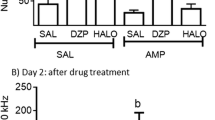Abstract
The behavioural effects of the D-1 dopamine receptor agonist SK & F 38393 were assessed in the intact adult rat using a conventional stereotypy rating scale and a rapid time sampling behavioural check list procedure. This combination technique allowed description of the nature of any behavioural response and quantification of the number of counts of individual behaviours. Using this combined procedure, SK & F 38393 clearly failed to induce typical stereotyped behaviour. However, in the well-habituated animal, SK & F 38393 dose-dependently increased the number of recordings of non-stereotyped sniffing, locomotion and grooming; some occasional rearing was also noted. An unusual pattern of intense grooming behaviour was a characteristic response to this drug. Using the resolved R-and S-enantiomers of SK & F 38393, promotion of sniffing, locomotion, rearing and grooming resided stereoselectively in the R-configuration. Under appropriate experimental conditions, specifically a requirement for prolonged habituation and the use of a rapid sampling behavioural check list to supplement the rating scale, it is possible to demonstrate that SK & F 38393 is behaviourally active in the whole animal.
Similar content being viewed by others
References
Breese GR, Napier TC, Mueller RA (1985) Dopamine agonist-induced locomotor activity in rats treated with 6-hydroxydopamine at differing ages: functional supersensitivity of D-1 dopamine receptors in neonatally lesioned rats. J Pharmacol Exp Ther 234:447–455
Creese IN, Sibley DR, Hamblin MW, Leff SE (1983) The classification of dopamine receptors: relationship to radio-ligand binding. Annu Rev Neurosci 6:43–71
Fray PJ, Sahakian BJ, Robbins TW, Koob GF, Iversen SD (1980) An observational method for quantifying the behavioural effects of dopamine agonists: contrasting effects of d-amphetamine and apomorphine. Psychopharmacology 69:253–259
Jolles J, Rompa-Barendregt J, Gispen WH (1979) Novelty and grooming behaviour in the rat. Behav Neural Biol 25:563–572
Kaiser C, Dandridge PA, Garvey E, Hahn RA, Sarau HM, Setler PE, Bass LS, Clardy J (1982) Absolute stereochemistry and dopaminergic activity of enantiomers of 2,3,4,5-tetrahydro-7,8-dihydroxy-1-phenyl-1H-3benzazepine. J Med Chem 25:697–703
Kamien JP, Woolverton WL (1985) The D-1 dopamine agonist SKF 38393 functions as a discriminative stimulus in rats. Psychopharmacology 87:368–370
Kuhn DM, Wolf WA, Youdim MBH (1985) 5-hydroxytryptamine release in vivo from a cytoplasmic pool: studies on 5-HT behavioural syndrome in reserpinized rats. Br J Pharmacol 84:121–129
Laduron P (1981) Dopamine receptor: a unique site with multiple postsynaptic localisation. In: Gessa GL, Corsini GU (eds) Apomorphine and other dopaminomimetics, vol 1. Raven, New York, pp 95–103
Lewis MH, Baumeister AA, McCorkle DL, Mailman RB (1985) A computerized method for analyzing behaviour observations: studies with stereotypy. Psychopharmacology 85:204–209
Molloy AG, Waddington JL (1984) Dopaminergic behaviour stereospecifically promoted by the D-1 agonist R-SK & F 38393 and selectively blocked by the D-1 antagonist SCH 23390. Psychopharmacology 82:409–410
Molloy AG, Waddington JL (1985) Sniffing, rearing and locomotor responses to the D-1 dopamine agonist R-SK & F 38393: differential interaction with the selective D-1 and D-2 antagonists SCH 23390 and metoclopramide. Eur J Pharmacol 108:305–308
Rebec GV, Bashore TR (1984) Critical issues in assessing the behavioural effects of amphetamine. Neurosci Biobehav Rev 8:153–159
Robbins TW (1977) A critique of the methods available for the measurement of spontaneous motor activity. In: Iversen LL, Iversen SD, Snyder SH (eds) Handbook of psychopharmacology. Plenum, New York, pp 37–82
Robbins TW, Sahakian BJ (1981) Behavioural and neurochemical determinants of drug-induced stereotypy. In: Rose FC (ed) Metabolic disorders of the nervous system. Pitman, London, pp 244–291
Rosengarten H, Schweitzer JW, Friedhoff AJ (1983) Induction of oral dyskinesias in naive rats by D-1 stimulation. Life Sci 33:2479–2482
Schmidt WJ (1986) Intrastriatal injection of DL-2-amino-5-phosphonovaleric acid (AP-5) induces sniffing stereotypy that is antagonised by haloperidol and clozapine. Psychopharmacology 90:123–130
Seeman P (1980) Brain dopamine receptors. Pharmacol Rev 32:229–313
Setler PE, Sarau HM, Zirkle CL, Saunders HL (1978) The central effects of a novel dopamine agonist. Eur J Pharmacol 50:419–430
Starr BS, Starr MS (1986) Grooming in the mouse is stimulated by the dopamine D-1 agonist SKF 38393 and by low doses of the D-1 antagonist SCH 23390, but is inhibited by dopamine D-2 agonists, D-2 antagonists and high doses of SCH 23390. Pharmacol Biochem Behav 24:837–839
Szechtman H, Ornstein K, Teitelbaum P, Gonali I (1985) The morphogenesis of stereotyped behaviour induced by the dopamine receptor agonist apomorphine in the laboratory rat. Neuroscience 14:783–798
Waddington JL (1986) Behavioural correlates of the action of selective D-1 dopamine receptor antagonists: impact of SCH 23390 and SKF 83566, and functionally interactive D-1:D-2 receptor systems. Biochem Pharmacol 35:3661–3667
Waddington JL, Cross AJ, Gamble SJ, Bourne RC (1982) Functional heterogeneity of multiple dopamine receptors during 6 months treatment with distinct classes of neuroleptic drugs. Adv Biosci 37:143–146
Author information
Authors and Affiliations
Rights and permissions
About this article
Cite this article
Molloy, A.G., Waddington, J.L. Assessment of grooming and other behavioural responses to the D-1 dopamine receptor agonist SK & F 38393 and its R- and S-enantiomers in the intact adult rat. Psychopharmacology 92, 164–168 (1987). https://doi.org/10.1007/BF00177909
Received:
Revised:
Issue Date:
DOI: https://doi.org/10.1007/BF00177909




